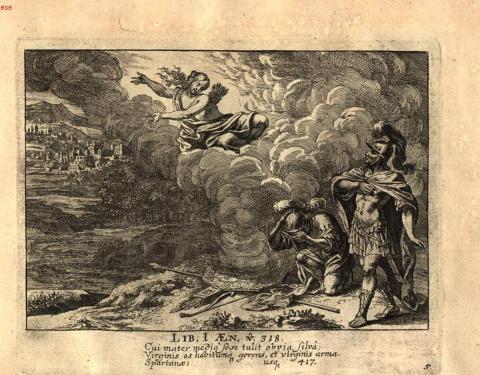Annotations
Venus (as a huntress with a quiver) appears in the clouds to Achates, who sinks to his knees, and Aeneas and shows them Carthage.
Venus (als Jägerin mit Köcher) erscheint in den Wolken dem Achates, der auf das Knie sinkt, und dem Aeneas und zeigt ihnen Karthago. (Suerbaum)
Engraving from a German children’s picture-book version of the Aeneid by G. J. Lang and G. C. Eimmart, “A tapestry of Roman virtues as seen in Vergil’s Aeneas and his brave deeds, rendered in sparkling engravings, as illustrations of the remarkable deeds of antiquity, for the common benefit of noble youth,” (Peplus virtutum Romanarum in Aenea Virgiliano eiusque rebus fortiter gestis, ad maiorem antiquitatis et rerum lucem, communi iuventutis sacratae bono, aere renitens) (Nuremburg: J.L. Buggel, 1688), pl. 5.


Venus in this engraving is dressed as Vergil describes at 314-320. She has a quiver hung over her shoulder and her hair is half undone, blowing in the wind behind her. One of her knees is even bare, as described at line 320. However, unlike in Vergil’s text, Venus is here obviously divine as she sits on a cloud, whereas in the text she does not reveal her divinity until the last moment as she turns away. Here she points out Carthage in the distance to the amazed Aeneas who stands on the right of the engraving as Achates shields his eyes from the goddess. (Lucy McInerney)